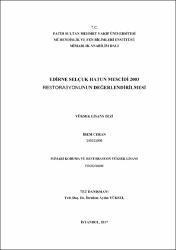Edirne Selçuk Hatun Mescidi 2003 Restorasyonunun Değerlendirilmesi
Citation
CERAN, İrem, Edirne Selçuk Hatun Mescidi 2003 restorasyonunun değerlendirilmesi, Fatih Sultan Mehmet Vakıf Üniversitesi Mühendislik ve Fen Bilimleri Enstitüsü Mimarlık Anabilim Dalı, Yayımlanmamış Yüksek Lisans Tezi, 2017Abstract
Medeniyet ve dünyaya şekil verme tasavvuru olan devletler eserlerini ve ifade tarzlarını gittikleri her yerde ortaya koymayı arzulamışlardır. Medeniyetler; kendi anlayışı ve üslubuyla biriktirdiği bilgiler nihayetinde edindiği tecrübe ile bir mimari dil oluşturmuştur. Osmanlı Medeniyeti de İslam’dan aldığı düsturlarla sosyal yaşamı ve insana hizmeti gaye edinmiş ve mimari uygulamalarında buna öncelik vermiştir. Böylece insana yakışır ve medeniyetini temsil eder eserler ortaya koymuştur. Her eserin bir kullanım gayesi ve işaret ettiği bir manası vardır.
Bu çalışma kapsamında, bir mahalle mescidi olarak yapılan Selçuk Hatun Mescidi ele alınmıştır. Mahalle mescitleri, sosyal hayat içerisinde mahalle sakinlerini toplayıp bir arada tutan ve beş vakit namazı cemaat ile eda edebilmeleri gayesi ile inşa edilmişlerdir. Baniyesi Mürsel kızı Selçuk Hatun, mimarı ise bilinmemektedir. 1456 senesinde Edirne’nin Sevindik Fakih Mahallesinde yapılmıştır. Eser, uzun yıllar metruk halde kalmış ve araştırmalar neticesinde, geçirdiği bir onarım kaydına rastlanmamıştır. Ancak tüm şartlara rağmen, mimari unsurları, son cemaat mahalli, ahşap elemanları hariç, hususiliğini koruyabilmiştir.
Hakkında fazla bilgi bulunmayan eserin yapıldığı dönemin anlaşılabilmesi için, Edirne Vakıflar Bölge Müdürlüğü, Edirne Rölöve Ve Anıtlar Müdürlüğü, Edirne Kültür Ve Tabiat Varlıklarını Koruma Kurulu ve Encümen Arşivleri incelenmiş; yazışmalar, eski fotoğraflar ve farklı kaynaklardan eser hakkında bilgi toplanmıştır.
Eserin 2003 yılında geçirdiği restorasyon uygulamasından önceki haline dair veriler, eski fotoğraf ve belgeler incelenerek, özgün haline ait üslup ve özellikleri anlaşılmaya çalışılmıştır. Elde edilen bilgi ve veriler ışığında, restitüsyon projeleri hazırlanmış ve titizlikle hazırlanan rölöve projeleriyle karşılaştırılarak, onarımda yapılan büyük hatalar görülmeye ve tespit edilmeye çalışılmıştır.
Projelerin içerisindeki izahatlar da görüleceği gibi, niteliksiz olan ekler kaldırılmış ve yapının özgün haline uygun üslup ve özelliklerini koruyan mimari unsurlar çizilerek detaylandırılmıştır.
Eser, işlevine uygun bir halde ve kullanılır vaziyettedir. Bakımlı ve temizdir. Ancak erken devir Osmanlı mimari üslubunun önemli unsurlarının korunması ve yaşatılması yerine, onarım esnasında daha pratik ve ekonomik olan çözümler tercih edilmiştir. Son cemaat mahallinin sadece üzerinin örtülmesi ve güncel ihtiyaçlara cevap vermesi için uygulanan ahşan sundurma çatı ile yapıya kalıcı zararlar verildiği tespit edilmiştir.
Edirne’nin erken devir Osmanlı mimarisine ait tek kubbeli camii ve mescitlerinden biri olan Selçuk Hatun Mescidi, 2003 yılında geçirdiği restorasyon uygulamasında ibadete açılmış ve hayata döndürülmüştür fakat, üslubuna ve hususiyetine zarar veren niteliksiz ekler kazandırılmıştır. Kıymetli eseri bu eklerden arındırmak ve aslına kavuşturmak, bu çalışmanın ana gayesidir ve çalışma bu gayelere ulaşmak üzere tamamlanmıştır. The states having the idea of civilization and forming the world wanted to put forward their works and their styles of expression to everywhere they go. The civilizations formed an architectural language thanks to the information they got experience in their understanding and style. The Ottoman Civilization aimed to serve to human being and social life with the principles taken from Islam and they prioritized this principle in their architectural applications. So, they put forward works decent and representing the civilization. Every single work has a meaning of usage and pointed purpose.
Within the scope of this study, Seljuk Hatun Mosque, constructed as a neighborhood mosque, is discussed. These neighborhood mosques were constructed so that the residents of the neighborhood would come together and perform their prayers in unison with a congregation five times a day. The founder of Seljuk Hatun Mosque is Seljuk Hatun, the daughter of Mürsel and its architect is not known. This mosque was built in Sevindik Fakih, Edirne in 1456. This structure has been abandoned for many years and as a result of some studies; it has been understood that there is no evidence that it has been restored. Despite of all the conditions, its architectural elements could maintain its originality except for the last congregation place and the wooden parts.
To be able to understand the period of the work (there could not be found so much information about it), the archives of Edirne Regional Directorate of Foundations, Edirne Directorate of Surveying and Monuments, Edirne Natural Heritage Protection Board and Commission archives have been investigated and the information about the work has been gathered from correspondences, old photographs and different kinds of sources.
It has been tried to understand the style and features belonging to the original by examining old photographs, documents and the data indicating the previous form of it before its restoration in 2003. In the light of the information and data in hand, restitution projects have been prepared and it has been studied to understand and establish the major errors during the restoration by comparing them with architectural survey projects prepared meticulously.
As can be seen with the explanations in the projects, unqualified adds have been removed and it has been detailed by drawing the architectural features suitable for originality and style of the building.
The structure is appropriate to its original function and in a useable situation. It is wellmaintained and clean. But instead of protecting and maintaining the important elements of the early ages Ottoman architectural style, more practical and economical solutions were chosen during the restoration. It has been stated that the structure was damaged permanently by only covering the place of the last congregation and with wooden porch roof implemented to respond to current needs.
Seljuk Hatun Mosque is one of the mosques which are single-domed and belong to the early ages of Edirne, Ottoman architecture. It was restored in 2003, opened for worship and brought back to life but it was brought unqualified adds damaging its original style and characteristics.
The main goal of this study is to remove these adds from this precious structure and make it turn back. And this work was completed to reach this goal.



















